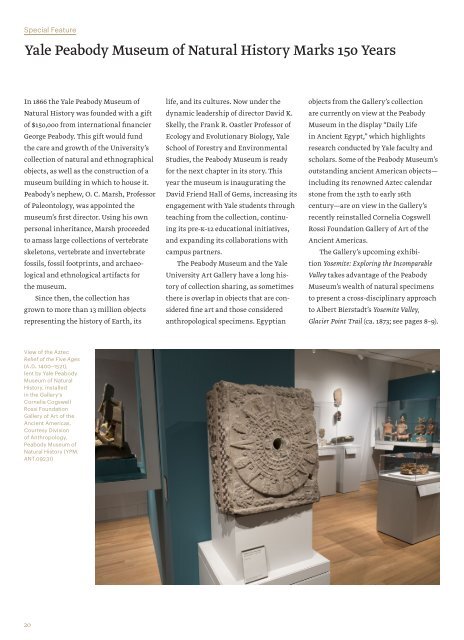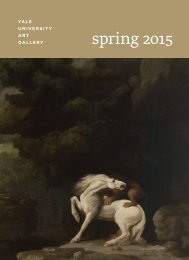MagFall2016_019_online_test
Create successful ePaper yourself
Turn your PDF publications into a flip-book with our unique Google optimized e-Paper software.
Special Feature<br />
Yale Peabody Museum of Natural History Marks 150 Years<br />
In 1866 the Yale Peabody Museum of<br />
Natural History was founded with a gift<br />
of $150,000 from international financier<br />
George Peabody. This gift would fund<br />
the care and growth of the University’s<br />
collection of natural and ethnographical<br />
objects, as well as the construction of a<br />
museum building in which to house it.<br />
Peabody’s nephew, O. C. Marsh, Professor<br />
of Paleontology, was appointed the<br />
museum’s first director. Using his own<br />
personal inheritance, Marsh proceeded<br />
to amass large collections of vertebrate<br />
skeletons, vertebrate and invertebrate<br />
fossils, fossil footprints, and archaeological<br />
and ethnological artifacts for<br />
the museum.<br />
Since then, the collection has<br />
grown to more than 13 million objects<br />
representing the history of Earth, its<br />
life, and its cultures. Now under the<br />
dynamic leadership of director David K.<br />
Skelly, the Frank R. Oastler Professor of<br />
Ecology and Evolutionary Biology, Yale<br />
School of Forestry and Environmental<br />
Studies, the Peabody Museum is ready<br />
for the next chapter in its story. This<br />
year the museum is inaugurating the<br />
David Friend Hall of Gems, increasing its<br />
engagement with Yale students through<br />
teaching from the collection, continuing<br />
its pre-K–12 educational initiatives,<br />
and expanding its collaborations with<br />
campus partners.<br />
The Peabody Museum and the Yale<br />
University Art Gallery have a long history<br />
of collection sharing, as sometimes<br />
there is overlap in objects that are considered<br />
fine art and those considered<br />
anthropological specimens. Egyptian<br />
objects from the Gallery’s collection<br />
are currently on view at the Peabody<br />
Museum in the display “Daily Life<br />
in Ancient Egypt,” which highlights<br />
research conducted by Yale faculty and<br />
scholars. Some of the Peabody Museum’s<br />
outstanding ancient American objects—<br />
including its renowned Aztec calendar<br />
stone from the 15th to early 16th<br />
century—are on view in the Gallery’s<br />
recently reinstalled Cornelia Cogswell<br />
Rossi Foundation Gallery of Art of the<br />
Ancient Americas.<br />
The Gallery’s upcoming exhibition<br />
Yosemite: Exploring the Incomparable<br />
Valley takes advantage of the Peabody<br />
Museum’s wealth of natural specimens<br />
to present a cross-disciplinary approach<br />
to Albert Bierstadt’s Yosemite Valley,<br />
Glacier Point Trail (ca. 1873; see pages 8–9).<br />
View of the Aztec<br />
Relief of the Five Ages<br />
(a.d. 1400–1521),<br />
lent by Yale Peabody<br />
Museum of Natural<br />
History, installed<br />
in the Gallery’s<br />
Cornelia Cogswell<br />
Rossi Foundation<br />
Gallery of Art of the<br />
Ancient Americas.<br />
Courtesy Division<br />
of Anthropology,<br />
Peabody Museum of<br />
Natural History (YPM.<br />
ANT.09231)<br />
20



